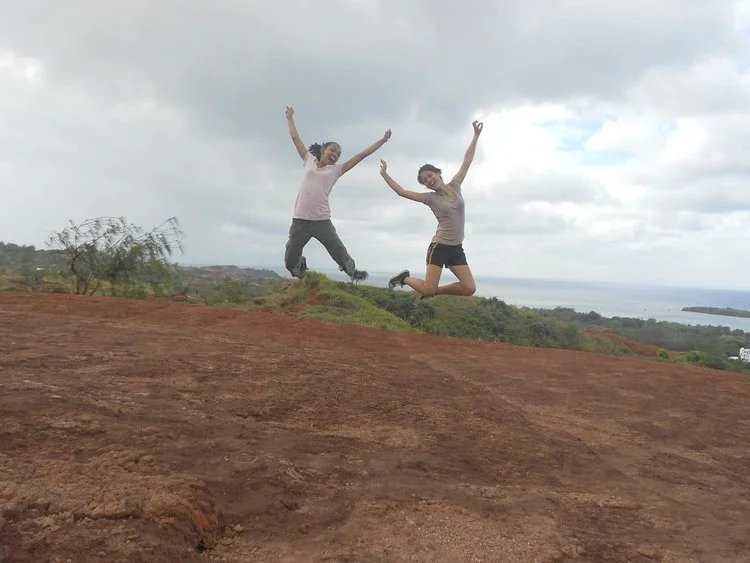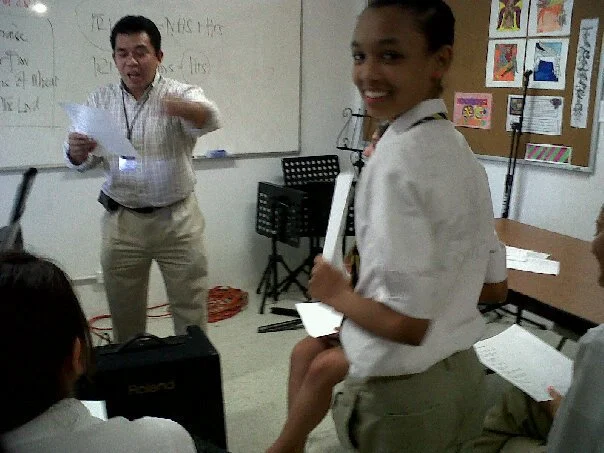My Story of Living with Anxiety
When I was a kid, aside from a few really bad nightmares, I was really adventurous and easy going.
I grew up in Guam (an island in the Pacific near Philippines)—pretty much in the boonies. I lived right next to the mountains, hills, a waterfall, and a river. It was normal for me to go hiking by myself, even though there was a very real threat of encountering a wild boar—or three.
It was also not unusual for me to go snorkeling in 40-foot-deep open ocean and to jump off high rocks to dive into the water that could very well have had a shark swimming in it.
Hiking in my “back yard” in Guam.
It wasn’t until I turned 14 that I started to experience crippling anxiety.
There were a variety of factors—physical and emotional abuse, my parents’ marriage falling apart, money was extremely tight so there was a general lack of resources and constant fear that we were going to lose our house or that there wasn’t going to be any leftovers after dinner to pack for my lunch the next day.
I also went to an academically challenging college prep high school for two years. It wasn’t the work that stressed me out so much as the fear I had of losing my full-ride scholarship and having to go back to homeschooling A.K.A. teaching myself from old textbooks that were sitting on the shelf at home.
A blurry picture of me in music class.
Fast forward to college, and the anxiety became almost all-consuming. I was working multiple jobs to put myself through school while working incredibly hard to get great grades to keep my scholarship.
At this point I’m 21 years old, and the anxiety had gone unchecked, unmanaged, and worse—unacknowledged. I truly thought that the tight chest, regular nightmares, rapid heart beat and constant fears were something that everyone experienced for the most part.
Regardless, I didn’t want confirmation that what I was going through wasn’t normal, so I kept it to myself, decided to generically label it all “stress,” and drowned myself in work so that I didn’t have to face it.
Then, the “ignore and keep going” tactic stopped working, and the anxiety started to manifest itself as back pain and migraines so severe that I couldn’t move. I had to miss work and class to stay at home under a blanket and popping Ibuprofen like there was no tomorrow.
Looking back, I didn’t really understand that what I had was an actual medical condition. What I had is something that could have been diagnosed and treated with therapy, medication, or a combination of the two.
I just thought I needed to figure it out. I thought that my hard childhood and my tendency to feel tense about...everything...was something I just had to handle unassisted for the rest of my life.
My back pain became so debilitating that I started tapping into the little money I did have to pay for massages, a chiropractor, a physical therapist, x-rays, and a spine specialist because I was convinced that the stabbing pain I had in my neck was due to nerve damage of some kind.
It wasn’t until I was at my spine specialist appointment and my doctor finished conducting a nerve test that I was told—for the first time in my life—that I might have clinical anxiety.
My doctor told me what I kind of feared—there was no nerve damage and no apparent physical cause for my back pain. She said that she sees what I’m going through a lot—severe anxiety causing physical pain in the body.
Although that wasn’t an official diagnosis by a mental health clinician—it was a start. I was prescribed medication for the pain, and I finally started to understand more of what I was going through, which helped me see a clearer path for what I needed to do and who I needed to see to get some help.
Jump ahead almost five years, I’m 25 with two kids, and I’ve gone through two bouts of postpartum anxiety and depression. I’ve been in therapy for two years, but not on any medication. The migraines, nightmares, and back pain returned with a vengeance.
Because I was no longer dealing with postpartum anxiety, I guess I didn’t realize that my typical “baseline” anxiety was still a lot for my body to deal with. I was worried, yet again, that I had a pinched nerve and because I had never had an MRI done, I wanted to make sure there was nothing physical once and for all.
Because I was having tingling and numbness, my neurologist was able to get the MRI approved. I anxiously (no surprise there) waited for the results. And guess what? There was nothing! No physical signs of pinched nerves, tumors, or anything that would be causing the pain I was in.
From there, I was told to start going to physical therapy, where I met a chronic pain specialist. He was this super down-to-earth guy who assured me that what I was experiencing was normal for people with anxiety. He said he struggles with anxiety too and his physical manifestation is a burning sensation in his chest and pelvis. He said for everyone it’s different.
He said there were some neck-strengthening exercises I should do to make my neck muscles stronger since that was the area where the pinching and burning feeling stemmed from, but ultimately, I needed to prioritize managing my anxiety.
He explained that when our bodies are in states of chronic anxiety, our nerves are firing constantly—always in fight or flight mode as if we’re in constant danger. We had to work on retraining my nervous system to function normally.
Since working with that physical therapist, I have figured out what works for me to keep my anxiety under control. However, this past month I’ve had a major flare up of my anxiety, migraines, and back pain due to being triggered by something significant from my past.
I want to mention this because you might discover a few things that keep your anxiety under control, but you need to know where you anxiety stems from (mine is almost entirely connected to the abuse in my childhood), and you have to be open to your anxiety management tool box evolving as you do.
For me, when my PTSD was triggered, my usual tactics of getting extra sleep, going out without my kids, meditating, journaling, therapy, and exercise didn’t do anything for me. At first, this was really frustrating. But, then I realized that when my anxiety is spiked due to being in a situation that reminds me of feeling unsafe as I did as a child, I need more support until I work through that trauma completely via EMDR therapy.
I made the decision to try an anti-anxiety medication, and I’m so glad I did. I don’t know how else I would have made it through this month of having so much past trauma brought back up without the additional support of medication.
It’s been a month now, and I take the medication on an as-needed basis. I’ve also been working with my therapist who encouraged me to continue EMDR therapy with a specialist to help me re-process the trauma I went through in addition to my usual tactics of journaling, yoga, meditation, and self-care.
I could sit here and write long descriptions of the benefits of journaling, meditation, believing in a higher power, but odds are, you’ve read a few Instagram posts about those already.
What I wanted to add to the conversation is that I believed that taking medication would be a failure on my part. But, what I’ve finally come to understand is that taking any step to acknowledge what I’ve been through and am going through and love myself enough to ask for help and get support is really what living with mental illness is all about.
At the end of the day, the techniques you will use to manage your anxiety are going to be different than mine. All I can tell you is to experiment with them all until you find a few that work for you. Be open to things evolving because some things might not work at different times in your life. And know that understanding the cause of your anxiety—knowing where it comes from—is key to figuring out a course of action that will help you to manage your anxiety and start living fully again.
While I’m currently in the process of re-evaluating what works and re-processing some trauma that came up, prior to this, I had several months of having my anxiety managed, and I can tell you that working towards that is well worth all the experimenting, evolving, and hard work it takes to get there.
Looking back on my journey, I wish I could go back to my 14-year-old self and tell her that the constant fear, migraines, and nightmares were not her fault. My anxiety wasn’t due to a lack of praying or believing in a higher power. It wasn’t due to not drinking enough water or whatever else people decided to blame it on.
Unmanaged anxiety is a huge burden that can affect every area of your life, and I want you to know that you don’t have to blame yourself for it or try to carry it alone anymore.
As I’m working this hard time right now, I’m reminding myself that I’ve conquered this before, and I can do it again. So, I hope that sharing this part of my story gives you hope and encourages you to love yourself, honor your struggle, and ask for help. Life is so much lighter when you do.
Looking for more support and community on your healing journey?
I’m a trauma-informed self-care coach. I have a group coaching program where I help women learn to love and care for themselves without guilt or shame. My approach is catered to people who live with mental health challenges and past trauma. Click here to learn more!


